Swirls & Streaks
Reprinted from "Crown Jewels of the Wire", August 2004, page 24
Every since Crown Jewels introduced the monthly feature "Insulator of
the Month", collectors have time and again told us their favorite
insulators are those with special character. Quite frequently, that character
involves swirls and streaks of color in the glass.
This month, we present a number of "swirly" insulators in a variety
of CD styles. And we are presenting them "life size". Now, some of
these photographs were taken more than a year ago. So while we don't have the
actual insulators in hand, we present them in a size appropriate to their CD
style. A problem with showing insulators "full size" is that we can't
present as many. But on the positive side, you get to see them as close to how
they appear as possible.
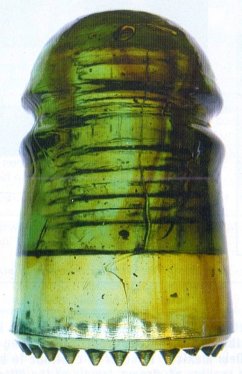
Nearly all older insulators, and some newer ones, can be found with swirls.
On this page, what would ordinarily have been a common, aqua, CD102 pony truly
became a Crown Jewel when impurities in the glass batch caused the beautiful
swirling you see here.
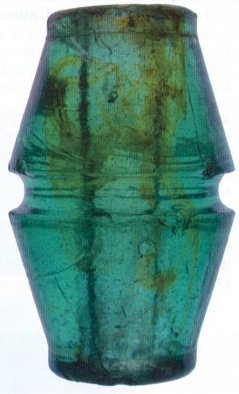
Something old, Something New. That amber swirls can be found in a wide range
of insulators is evidenced by the two shown on this page. The CD 700.1
threadless "egg" telegraph insulator shown above dates from the
1850's. Here the amber swirling is so extensive that the entire insulator color
has been changed from aqua to green tones. Swirling in small amounts can be
found in a great many insulators. But when the swirling dominates the glass, the
insulator becomes a Crown Jewel.
The CD 113 Hemingray # 12 shown below is one-hundred years newer than
the "egg". In this case, a broad band of amber appears orange when
encased in clear glass.
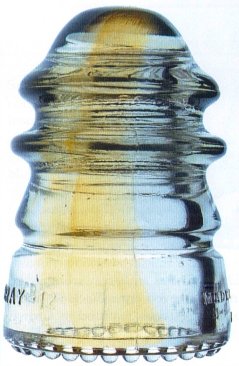
Why so popular? Swirling can turn the ordinary into something extraordinary.
What a surprise it can be to find colorful swirls of glass dancing around inside
an insulator. And ordinary style insulators, even with swirls, are often not
expensive.
Not every collector can afford to purchase a popular style like a CD 159
Gregory, or a CD 119 Brookfield. Some styles, like the CD 111 are unique and not
available to any collector.
But everyone can obtain an insulator that because of its swirls is unique in
and of itself.
(page 25)
What Causes Swirling?
For the answer to what causes those fun swirls everyone seems to love so
much, we present a excepts from an article written by Mark Lauckner and
published in the July 2000 issue of Crown Jewels.
Mark writes, "What causes amber streaks? Amber streaks are caused by
iron oxide (rust) or ferrous containing metals in. the glass. Just one little
fleck or rust or scrap iron causes a nice amber streak when poured. If rusty
steel or iron ladles were used to pour insulators, rust flecks would be left in
the glass tank after each time the ladle was dipped in. These flecks would melt
and make little regions of dark green glass waiting for the ladle to come back
and scoop them up for the next pour. Iron oxide is one of the chemicals used for
coloring glass green. When we refer to amber streaking in glass, it's usually
green that we see."
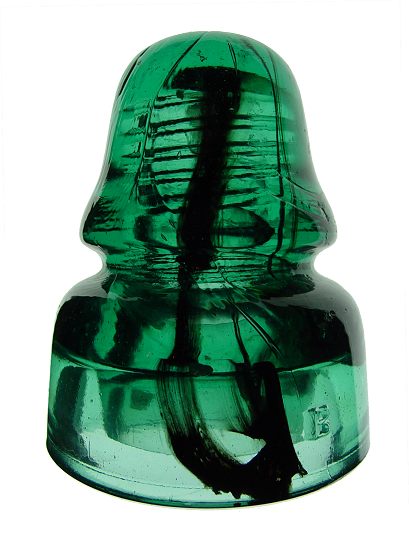
In some insulators, as in this CD 162.5, the amber swirling is so dramatic
that it dominates the insulator even in a black & white photograph. This
particular insulator has been featured in Crown Jewels on several occasions.
(page 26)
Lauckner continues in his article, "What causes milk streaks?
"Milk" or non-transparent streaks are the result of accidental
contamination by a chemical oxide which acts as an opacifier in the glass, or
the deliberate addition of these chemicals in the previous furnace batch to
produce opalescent or opaque glass.
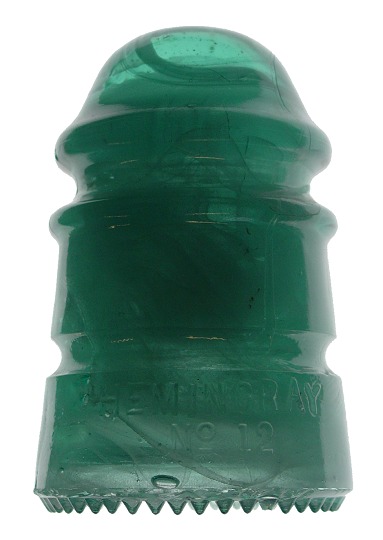
Small milk streaks in insulator would certainly suggest undesired
contamination in the glass tank, while the full swirled milky insulators (like
the Hemingray 12 above) would suggest that transparent glass was loaded on top
of a previous run of opaque or "milk glass", and that some mixing
action in the glass tank had partially blended the two together."
Lauckner's article is called, "The Birth of an Insulator". It's 11
pages in length and features 17 color photographs. The article explains how
"leaners" are formed, what causes underpours, what creates
"snow" in insulator glass, how foreign objects such as nails get
inside insulators, what causes creases and lines on insulators, what causes two
tone insulators, black bubbles and much more. The article is available in
booklet form from Crown Jewels for the price of just $1.00 each to cover postage
and handling. Or, 20 copies can be ordered for $10 post paid (for distribution
at shows or club meetings.)
(page 27)
The Hemingray #9, a CD 106, is one of the most common insulators ever
manufactured.
But Hemingray #9's can often be found with heavy amber swirling.
Here a common insulator becomes a unique piece of glass that can still be
acquired at a modest price, or perhaps found undiscovered in a junk box because
the swirls are hidden under soot and dirt.
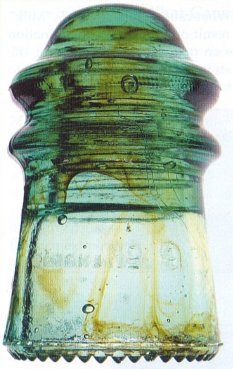
An earlier style of insulator is the Hemingray CD 124.
These are normally found in a plain aqua color.
Examples in bright colors, even when the colors are caused by amber swirls,
are much more difficult to come by.
In this example, it doesn't appear that the Hemingray company had quite
perfected the concept of drip points at the time they made this insulator.

(page 28)
CD 125' s are a large, heavy, bulky insulator. Most frequently a Hemingray
product, the style was possibly introduced to compete with Brookfield's CD 126
"blobtop" design for telegraph insulators.
Early 125's are often embossed W.U. for the Western Union Telegraph Company.
The style is popular to collect because examples are occasionally found in
bright colors including purple, dark sapphire blue, yellow green, and yellow
olive green. (See the CD 125 on page 41, for example.)
But examples dominated by heavy amber swirls are also difficult to find and
equally desirable.

(page 29)
More on the cause of Swirls
Rust and flakes of metal are likely just one of the causes for the colorful
swirls we see in insulator glass.
In their book, "Insulators: A History and Guide to North American Pintype
Insulators, Volume 1", John and Carol McDougald wrote the following:
'Another commodity necessary for the production of insulators or any other
glass product is broken glass (cullet). In a letter received from Mr. N.R.
Woodward, author of "The Glass Insulator in America, 1988 Report", regarding
insulator colors, he shared the following:
'I think collectors often do not really comprehend the process of glass
manufacture on the commercial scale that was used to produce insulators. All
glass is composed of raw materials with sand as the primary ingredient, and cullet. All glass manufacture requires some cullet. Or (and this is important)
it can be all cullet. It cannot be all raw materials without cullet. Thus we
have our recycling efforts in many cities, where bottles are taken in and sorted
by color -- clear, brown and green.
'Back when the colored insulators were made, especially prior to World War I,
little attention was paid to color. The various manufacturers used different
methods. In one of their advertisements, Hemingray emphasized that glass should
be made with "not too much cullet". This was no doubt a slap at
Brookfield,
McLaughlin and others who largely used cullet. (See the ad on the opposite
page.)
'Natural glass color depends on the grade of sand used. The greater the iron
content the darker the aqua colors. If not a great deal of cullet is used, or if
it is clear glass, the color will remain fairly constant as long as the sand
source is not changed. As the cullet is increased, the colors will be affected;
and when a dark colored bottle was ground up and not completely mixed with other
glass, it would make a streak in the insulator. During the early years of the
(20th) century, we find amber streaks in some of the Hemingray insulators that
are generally of a uniform aqua color. Going back further, the Covington
production varied from some runs made with a high grade silica sand and of
uniform light tint, to others that seem to have been largely cullet and come in
every imaginable color.
'Brookfield used tremendous amounts of cullet at the Old Bridge plant and we
find not only dark green and brown streaks, but also pieces that were made with
a uniform mix of different colors and came out yellow-green, dark olive, etc.
'At times in every operation there were undoubtedly large amounts of a single
color of cullet brought in. A large number of clear bottles would lead to a
light purple and smoke glass so prized by collectors. At one time years ago when
I showed William McLaughlin one of his very dark green insulators, he said,
"Yes, we bought a truck load of green
ginger ale bottles from a defunct bottling works."
'Thus it can be seen that for the most part, the colors were unintentional,
and there is no limit to their variety. In more recent times where the buyers
became more particular, cullet was carefully controlled and decolorizing
formulae were used to produce essentially clear glass. But as collectors know,
there are occasional streaks of color even in late production.
'Other factors affecting color were, of course, the intentional blues and
ambers at Hemingray resulting from the addition of the proper minerals to the
mix; also the yellow and purples that resulted from attempts at decolorizer
formulae.'

(page 31)
CENTER PIECES
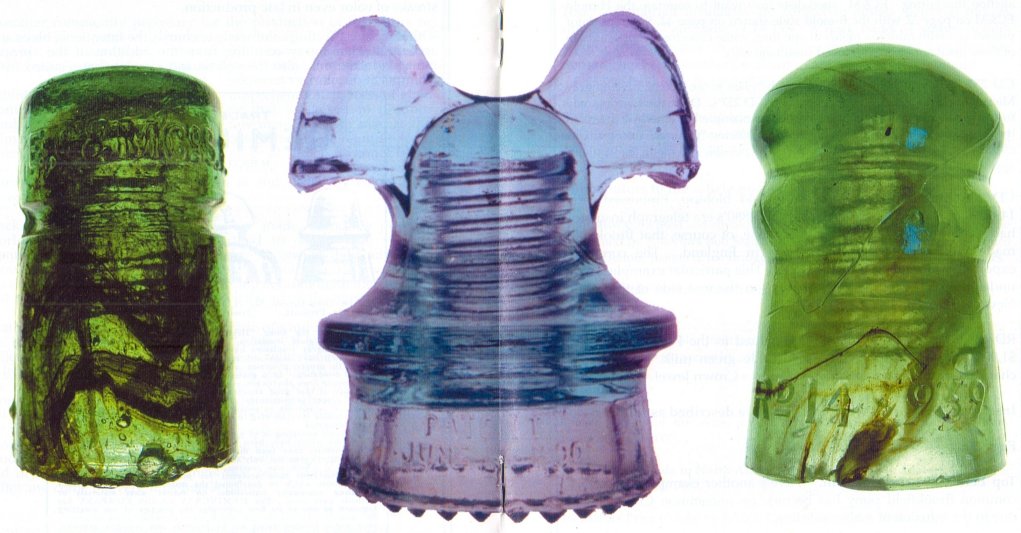
See page 34 for details about these insulators.
(page 32, 33)
Featured as our life sized centerfold pictures (pages 32-33) were:
CD 123 EC&M CO. SF. Aqua is the typical color for EC&M's. But they
are also famous for bright colors such as cobalt blue, olive amber, and deep
green. Minor amber swirling occurs frequently in CD 123' s. But when the
swirling dominates the insulator, the value soars. While not even as pronounced
as the EC&M shown on page 32, another heavily swirled EC&M brought
$5,775 at auction this spring. EC&M specialists may want to compare the
H-mold EC&M on page 32 with the B-mold style shown on page 44. Since
insulator presses ran with multiple molds at one time, some collectors wonder if
both of these insulators were produced simultaneously.
CD 257 "Mickey Mouse". All that solid glass in the ears of a
Hemingray Mickey Mouse add to the attractiveness of CD 257's. Dramatic swirling
only further enhances the appeal. This particular example has amethyst swirls in
the ears of an insulator otherwise described as being "ice aqua" in
color. Our efforts to show the amethyst swirls as best as possible has made the
insulator appear bluer than it really is.
CD 126 Blobtop. This is no Brookfield blobtop. Embossed "RD
149959", it is widely perceived that this 1880's era telegraph insulator
had its origins in England. It is possible, of course, that Brookfield made the
insulator for distribution in England. The company exported insulators on a
regular basis. This particular example, as we understand, was found in
California, on the east side of the Sierra Nevada mountains.
RD 149959 embossed blobtops are valued in the Price Guide from $1,000 in
green aqua to $1,750 for jade green milk. The special character of this specimen
makes it truly a Crown Jewel.
Insulators on the following two pages are described as follows:
Page 36:
Top Left: CD 102 Brookfield. Here's another example of where a common
Brookfield pony has become an uncommon Crown Jewel due to the infusion of amber
swirling.
Top Right: CD 101 Brookfield. This entire insulator is one big amber swirl,
with various degrees of intensity. Did Brookfield intend to make an amber
insulator? Or was there so much impurities in the batch of glass that the
insulator just came out looking amber? Is it a example of "too much
cullet"?
(page 34)
Page 36, continued:
Bottom: Here's a CD 127 Brookfield with a band of amber that weaves its way around and round the insulator.
Page 37:
Top: Canadian insulators are subject to amber swirling, too, as shown by this
"no name" CD 133. A dark band of amber hovers around the wire groove,
while lighter amber streaks brighten the dome. This is yet another insulator
made greener than it would otherwise be due to the impurities in the glass.
Bottom: Mexican insulators also become Crown Jewels due to swirling and its
affects. This is a CD 162.7 Derf showing swirling throughout, but particularly
strong in the dome.
Contributors to the article on swirled insulators:
Insulators: Swirled and streaked insulators shown in this month's magazine
are owned by collectors Bob Stahr, Bill Ostrander, Dwayne Anthony, James
"Pete" Dennis, Jeanne & Joe Bridges, Doug Williams, Mike Corn and
others.
Photographs: Pictures were taken by Bill Ostrander, Ray Klingensmith &
Howard Banks.
Color Printing: Color printing is made possible by a generous grant given to
Crown Jewels magazine by collector Tommy Bolack.
References:
Crown Jewels of the Wire, article "The Birth of an Insulator", by
Mark Lauckner, July 2000.
A History & Guide to North American Glass Pin type Insulators, by John
& Carol McDougald, 1990.
Insulators Price Guide, by John & Carol McDougald, 2003.
Hemingray advertisement reproduced from: The Hemingray Glass Company, A Most
Colorful History, by H.G. "BEA" Hyve, 1998
(page 35)
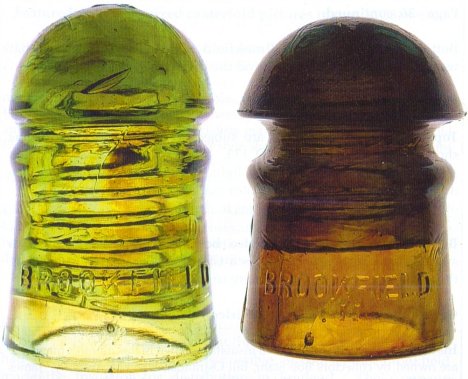

(page 36)
See Pages 34-35 for descriptions of these insulators.
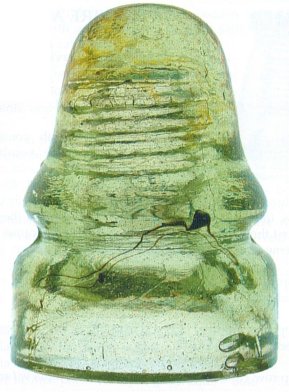
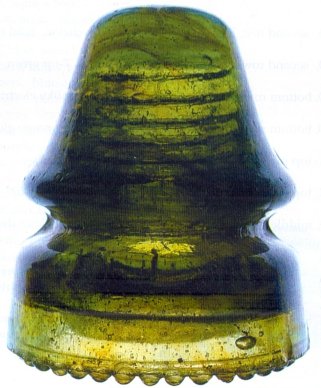
(page 37)
| 